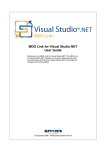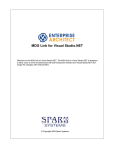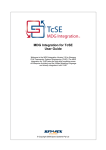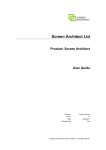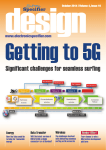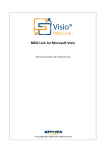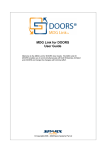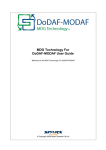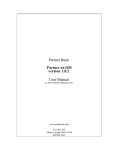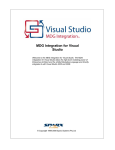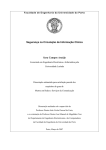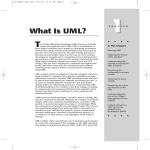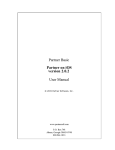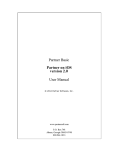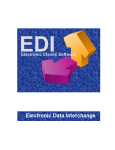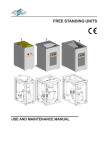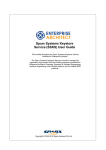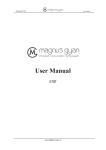Download MDG Link for Eclipse User Guide
Transcript
MDG Link for Eclipse User Guide Welcome to the MDG Link for Eclipse. The MDG Link for Eclipse enables you to work simultaneously with both Enterprise Architect and Eclipse and merge the changes with minimal effort. © Copyright 1998 - 2008 Sparx Systems Pty Ltd MDG Link For Eclipse User Guide Introduction by Daniel Zhan MDG Link for Eclipse provides a light weight bridge between Enterprise Architect and Eclipse MDG Link for Eclipse User Guide © 1998 - 2008 Sparx Systems Pty Ltd All rights reserved. No parts of this work may be reproduced in any form or by any means - graphic, electronic, or mechanical, including photocopying, recording, taping, or information storage and retrieval systems - without the written permission of the publisher. Products that are referred to in this document may be either trademarks and/or registered trademarks of the respective owners. The publisher and the author make no claim to these trademarks. While every precaution has been taken in the preparation of this document, the publisher and the author assume no responsibility for errors or omissions, or for damages resulting from the use of information contained in this document or from the use of programs and source code that may accompany it. In no event shall the publisher and the author be liable for any loss of profit or any other commercial damage caused or alleged to have been caused directly or indirectly by this document. Printed: May 2008 Publisher Sparx Systems Managing Editor Geoffrey Sparks Technical Editor Daniel Zhan Special thanks to: All the people who have contributed suggestions, examples, bug reports and assistance in the development of MDG Link for Eclipse. The task of developing and maintaining this tool has been greatly enhanced by their contribution. I MDG Link for Eclipse User Guide Table of Contents Foreword Welcome 1 2 Copyright ................................................................................................................................... Notice 4 Software Product ................................................................................................................................... License Agreement 5 Acknowledgement ................................................................................................................................... of Trademarks 8 System Requirements ................................................................................................................................... 9 Support ................................................................................................................................... 10 Order MDG ................................................................................................................................... Link for Eclipse 11 Getting Started 12 Install MDG ................................................................................................................................... Link 12 Register the ................................................................................................................................... MDG Link for Eclipse 13 Eclipse Options ................................................................................................................................... 15 Set Up the ................................................................................................................................... MDG Link 17 Create a Link ................................................................................................................................... to an Eclipse Project 18 Merge for................................................................................................................................... the First Time 20 Perform Tasks with MDG Link for Eclipse 21 Add-In Options ................................................................................................................................... from the Project Browser 21 Add-In Menu .......................................................................................................................................................... Items Locate Elements .......................................................................................................................................................... Edit Classes .......................................................................................................................................................... Edit Operations .......................................................................................................................................................... Edit Attributes .......................................................................................................................................................... 21 21 21 22 23 Build Project ................................................................................................................................... 25 Build and.......................................................................................................................................................... Run a Project Build Dialog .......................................................................................................................................................... Options Build Project .......................................................................................................................................................... Errors 25 26 26 Classes ................................................................................................................................... 28 Create Class .......................................................................................................................................................... Edit Class .......................................................................................................................................................... Edit Class, .......................................................................................................................................................... Switch to Eclipse Edit Class .......................................................................................................................................................... Attributes and Operations Add Inheritance .......................................................................................................................................................... to Classes Add Class .......................................................................................................................................................... and Find Association Links Code 29 30 31 32 33 34 ................................................................................................................................... 36 Edit Code.......................................................................................................................................................... Add Code.......................................................................................................................................................... Comments 36 37 Diagrams................................................................................................................................... 39 Format a .......................................................................................................................................................... Diagram 39 Round Trip ................................................................................................................................... Engineering 40 Merge Options .......................................................................................................................................................... Merge Project .......................................................................................................................................................... Dialog Options Forward Engineering .......................................................................................................................................................... Forward ......................................................................................................................................................... Engineering from a Class © 1998 - 2008 Sparx Systems Pty Ltd 40 40 42 42 Contents II Forward ......................................................................................................................................................... Engineering with a Merge Assign ......................................................................................................................................................... Classes to Files for Export Reverse Engineering .......................................................................................................................................................... Reverse ......................................................................................................................................................... Engineer from an Eclipse Source Class Reverse ......................................................................................................................................................... Engineer with a Merge Synchronize .......................................................................................................................................................... Code and Model Index 43 43 44 44 45 45 47 © 1998 - 2008 Sparx Systems Pty Ltd 1 Foreword Foreword MDG Link for Eclipse provides a light weight bridge between Enterprise Architect and Eclipse. © 1998 - 2008 Sparx Systems Pty Ltd 2 1 Welcome Welcome to the Model Driven Generator Link™ for Eclipse™. MDG Link for Eclipse is designed to enable users to work simultaneously with both Enterprise Architect and Eclipse and merge the changes with minimal effort. MDG Link for Eclipse works with both the Professional and Corporate editions of Enterprise Architect and provides a tight integration between Enterprise Architect and Eclipse, enabling you to either create UML in Enterprise Architect or to generate UML from Eclipse. MDG Link for Eclipse has the following features: · · · · Provides a simple, easy to use connection between Enterprise Architect models and Eclipse projects. Enables you to merge an entire project simply and easily. Provides support for different development configurations. Prompts you with the proposed merge before changes are written. © 1998 - 2008 Sparx Systems Pty Ltd 3 MDG Link for Eclipse User Guide To get started now, see Getting Started See Also · License Agreement · Copyright Notice 4 5 © 1998 - 2008 Sparx Systems Pty Ltd 17 . Copyright Notice 4 1.1 Copyright Notice Copyright © 1998 - 2008 Sparx Systems Pty. Ltd. All rights reserved. The software contains proprietary information of Sparx Systems Pty Ltd. It is provided under a license agreement containing restrictions on use and disclosure and is also protected by copyright law. Reverse engineering of the software is prohibited. Please read the license agreement 5 for full details. Due to continued product development, this information may change without notice. The information and intellectual property contained herein is confidential between Sparx Systems and the client and remains the exclusive property of Sparx Systems. If you find any problems in the documentation, please report them to us in writing. Sparx Systems does not warrant that this document is error-free. No part of this publication may be reproduced, stored in a retrieval system, or transmitted in any form or by any means, electronic, mechanical, photocopying, recording or otherwise without the prior written permission of Sparx Systems. Licensed users are granted the right to print a single hardcopy of the user manual per licensed copy of the software, but may not sell, distribute or otherwise dispose of the hardcopy without written consent of Sparx Systems. Sparx Systems Pty. Ltd. 7 Curtis St, Creswick, Victoria 3363, AUSTRALIA Phone: +61 (3) 5345 1140 Fax: +61 (3) 5345 1104 Support Email: [email protected] Sales Email: [email protected] Website: www.sparxsystems.com Eclipse is Copyright (c) Eclipse contributors and others. website: http://www.eclipse.org/platform © 1998 - 2008 Sparx Systems Pty Ltd MDG Link for Eclipse User Guide 5 1.2 Software Product License Agreement MDG Link for Eclipse Copyright (C) 1998-2008 Sparx Systems Pty Ltd. All Rights Reserved IMPORTANT-READ CAREFULLY: This End User License Agreement ("EULA") is a legal agreement between YOU as Licensee and SPARX for the SOFTWARE PRODUCT identified above. By installing, copying, or otherwise using the SOFTWARE PRODUCT, YOU agree to be bound by the terms of this EULA. If YOU do not agree to the terms of this EULA, promptly return the unused SOFTWARE PRODUCT to the place of purchase for a full refund. The copyright in the SOFTWARE PRODUCT and its documentation is owned by Sparx Systems Pty Ltd A.B.N 38 085 034 546. Subject to the terms of this EULA, YOU are granted a non-exclusive right for the duration of the EULA to use the SOFTWARE PRODUCT. YOU do not acquire ownership of copyright or other intellectual property rights in any part of the SOFTWARE PRODUCT by virtue of this EULA. Your use of this software indicates your acceptance of this EULA and warranty. DEFINITIONS In this End User License Agreement, unless the contrary intention appears: · · · · · · · · "EULA" means this End User License Agreement "SPARX" means Sparx Systems Pty Ltd A.B.N 38 085 034 546 "Licensee" means YOU, or the organization (if any) on whose behalf YOU are taking the EULA. "Registered Edition of MDG Link for Eclipse" means the edition of the SOFTWARE PRODUCT which is available for purchase from the web site: http://www.sparxsystems.com/products/mdg/link/eclipse/ purchase.html. "SOFTWARE PRODUCT" or "SOFTWARE" means MDG Link for Eclipse, which includes computer software and associated media and printed materials, and may include online or electronic documentation. "Support Services" means email based support provided by SPARX, including advice on usage of MDG Link for Eclipse, investigation of bugs, fixes, repairs of models if and when appropriate and general product support. "Trial edition of MDG Link for Eclipse" means the edition of the SOFTWARE PRODUCT which is available free of charge for evaluation purposes for a period of 30 days. "SPARX support engineers" means employees of SPARX who provide on-line support services. GRANT OF LICENSE In accordance with the terms of this EULA YOU are granted the following rights: a) To install and use one copy of the SOFTWARE PRODUCT, or in its place, any prior version for the same operating system, on a single computer. As the primary user of the computer on which the SOFTWARE PRODUCT is installed, YOU may make a second copy for your exclusive use on either a home or portable computer. b) To store or install a copy of the SOFTWARE PRODUCT on a storage device, such as a network server, used only to install or run the SOFTWARE PRODUCT over an internal network. If YOU wish to increase the number of users entitled to concurrently access the SOFTWARE PRODUCT, YOU must notify SPARX and agree to pay an additional fee. c) To make copies of the SOFTWARE PRODUCT for backup and archival purposes. EVALUATION LICENSE The Trial version of MDG Link for Eclipse is not free software. Subject to the terms of this agreement, YOU are hereby licensed to use this software for evaluation purposes without charge for a period of 30 days. Upon expiration of the 30 days, the Software Product must be removed from the computer. Unregistered use of MDG Link for Eclipse after the 30-day evaluation period is in violation of Australian, U.S. and international copyright laws. SPARX may extend the evaluation period on request and at their discretion. If YOU choose to use this software after the 30 day evaluation period a license must be purchased (as described at http://www.sparxsystems.com/products/mdg/eclipse/doors/purchase.html). Upon payment of the License fee, YOU will be sent details on where to download the registered edition of MDG Link for Eclipse and will be provided with a suitable software 'key' by email. © 1998 - 2008 Sparx Systems Pty Ltd Software Product License Agreement 6 ADDITIONAL RIGHTS AND LIMITATIONS. YOU hereby undertake not to sell, rent, lease, translate, adapt, vary, modify, decompile, disassemble, reverse engineer, create derivative works of, modify, sub-license, loan or distribute the SOFTWARE PRODUCT other than as expressly authorized by this EULA. YOU further undertake not to reproduce or distribute license key-codes except under the express and written permission of SPARX. ASSIGNMENT YOU may only assign all your rights and obligations under this EULA to another party if YOU supply to the transferee a copy of this EULA and all other documentation including proof of ownership. Your License is then terminated. TERMINATION Without prejudice to any other rights, SPARX may terminate this EULA if YOU fail to comply with the terms and conditions. Upon termination YOU or YOUR representative shall destroy all copies of the SOFTWARE PRODUCT and all of its component parts or otherwise return or dispose of such material in the manner directed by SPARX. WARRANTIES AND LIABILITY WARRANTIES SPARX warrants that the SOFTWARE PRODUCT will perform substantially in accordance with the accompanying written materials for a period of ninety (90) days from the date of receipt, and any Support Services provided by SPARX shall be substantially as described in applicable written materials provided to YOU by SPARX, and SPARX support engineers will make commercially reasonable efforts to solve any problems associated with the SOFTWARE PRODUCT. EXCLUSIONS To the maximum extent permitted by law, SPARX excludes, for itself and for any supplier of software incorporated in the SOFTWARE PRODUCT, all liability for all claims , expenses, losses, damages and costs made against or incurred or suffered by YOU directly or indirectly (including without limitation lost costs, profits and data) arising out of: · YOUR use or misuse of the SOFTWARE PRODUCT · YOUR inability to use or obtain access to the SOFTWARE PRODUCT · Negligence of SPARX or its employees, contractors or agents, or of any supplier of software incorporated in the SOFTWARE PRODUCT, in connection with the performance of SPARX'S obligations under this EULA, or · Termination of this EULA by either party for any reason. LIMITATION The SOFTWARE PRODUCT and any documentation are provided "AS IS" and all warranties whether express, implied, statutory or otherwise, relating in any way to the subject matter of this EULA or to this EULA generally, including without limitation, warranties as to: quality, fitness; merchantability; correctness; accuracy; reliability; correspondence with any description or sample, meeting your or any other requirements; uninterrupted use; compliance with any relevant legislation and being error or virus free are excluded. Where any legislation implies in this EULA any term, and that legislation avoids or prohibits provisions in a contract excluding or modifying such a term, such term shall be deemed to be included in this EULA. However, the liability of SPARX for any breach of such term shall if permitted by legislation be limited, at SPARX'S option to any one or more of the following upon return of the SOFTWARE PRODUCT and a copy of the receipt: · If the breach relates to the SOFTWARE PRODUCT: · the replacement of the SOFTWARE PRODUCT or the supply of an equivalent SOFTWARE PRODUCT · the repair of such SOFTWARE PRODUCT · the payment of the cost of replacing the SOFTWARE PRODUCT or of acquiring an equivalent SOFTWARE PRODUCT, or · the payment of the cost of having the SOFTWARE PRODUCT repaired. · If the breach relates to services in relation to the SOFTWARE PRODUCT: · the supplying of the services again, or · the payment of the cost of having the services supplied again. © 1998 - 2008 Sparx Systems Pty Ltd 7 MDG Link for Eclipse User Guide TRADEMARKS All names of products and companies used in this EULA, the SOFTWARE PRODUCT, or the enclosed documentation may be trademarks of their corresponding owners. Their use in this EULA is intended to be in compliance with the respective guidelines and licenses. Windows, Windows NT, Windows ME, Windows XP and Windows 2000 are trademarks of Microsoft. GOVERNING LAW This agreement shall be construed in accordance with the laws of the Commonwealth of AUSTRALIA. © 1998 - 2008 Sparx Systems Pty Ltd Acknowledgement of Trademarks 8 1.3 Acknowledgement of Trademarks Trademarks of Microsoft · Windows® Registered Trademarks of OMG · · · · · · CORBA® The OMG Object Management Group logo The Information Brokerage® CORBA Academy® IIOP® XMI® Trademarks of OMG · · · · · · · · · · · · · · · · · · · · · OMG™ Object Management Group™ the CORBA logo ORB™ Object Request Broker™ the CORBA Academy design OMG Interface Definition Language™ IDL™ CORBAservices™ CORBAfacilities™ CORBAmed™ CORBAnet™ Unified Modeling Language™ UML™ the UML Cube logo MOF™ CWM™ Model Driven Architecture™ MDA™ OMG Model Driven Architecture™ OMG MDA™ © 1998 - 2008 Sparx Systems Pty Ltd MDG Link for Eclipse User Guide 9 1.4 System Requirements The following software must be installed in order to use the MDG Link for Eclipse: Operating System · · · · · Windows XP Professional (SP2 or later) Windows XP Home Edition (SP2 or later) Windows XP Media Center Edition (SP2 or later) Windows XP Tablet PC Edition (SP2 or later) Windows 2000 Professional (SP5 or later required for installation) Enterprise Architect · Enterprise Architect Version 7.1 Professional Edition, or · Enterprise Architect Version 7.1 Corporate Edition Eclipse · Eclipse version 3.1 or higher Other · Sun JDK 1.5 © 1998 - 2008 Sparx Systems Pty Ltd Support 10 1.5 Support Technical support for the MDG Link for Eclipse is available to registered users of Enterprise Architect. Responses to support queries are sent by email. Sparx Systems endeavors to provide a rapid response to all product-related questions or concerns. Registered users can lodge a support request, by visiting: http://www.sparxsystems.com/registered/reg_support.html. Trial users can contact Sparx Systems with questions regarding their evaluation at: [email protected]. An online user forum is also available for your questions and perusal, at http://www.sparxsystems.com/cgi-bin/yabb/YaBB.cgi. © 1998 - 2008 Sparx Systems Pty Ltd 11 MDG Link for Eclipse User Guide 1.6 Order MDG Link for Eclipse MDG Link for Eclipse is designed, built and published by Sparx Systems and is available from Sparx Systems. The latest information on pricing and purchasing is available at: Sparx Systems Purchase/Pricing Website. For more information, contact [email protected]. Once you have paid for a licensed version of the MDG Link for Eclipse, you receive (via email or other suitable means) a license key for each installation, and the address of the web site from which to download the full version. © 1998 - 2008 Sparx Systems Pty Ltd Install MDG Link 12 2 Getting Started 2.1 Install MDG Link MDG Link for Eclipse is available for download from the MDG Link for Eclipse page on the Sparx Systems Website. Once it has been downloaded the program is in .exe format. To install MDG Link for Eclipse follow the steps below: 1. Download the EAEclipse.exe file from the Sparx Systems website. 2. Ensure that you meet the System Requirements 9 and have the appropriate versions of Enterprise Architect and Eclipse 3.1 installed on your system. 3. Double-click on the EAEclipse.exe Installer executable to install the MDG Link for Eclipse component. 4. Read the licensing agreement and, if you accept the terms, click on the Next button. 5. Read the Readme information. Click on the Next button. 6. In the User name and Organization name fields, type your user name and organization name. Click on the Next button. (Optionally determine the users who have access to this program by choosing All users or only registering certain users). 7. Type in an installation path for the program (or accept the default path). Click on the Next button. 8. Browse for and enter the correct plugin directory pathname. Click on the Next button twice. 9. Click on the Finish button. © 1998 - 2008 Sparx Systems Pty Ltd 13 MDG Link for Eclipse User Guide 2.2 Register the MDG Link for Eclipse To activate the MDG Link for Eclipse, follow the steps below: 1. Purchase one or more licenses. Once you have paid for a licensed version of MDG Link for Eclipse, you receive (via email or other suitable means): · a license key or keys · the address of the web site from which to download the full version. 2. Download the latest full install package from the address supplied. 3. Run the setup program 12 to install the full version. 4. Start Enterprise Architect. If this is the first time you have installed MDG Link for Eclipse, the MDG Link for Eclipse dialog displays prompting you to register the MDG Link or to continue the trial. 5. To enter the new key click on the Enter Key button. The License Management dialog displays. 6. Click on the Add Key button. The Add Registration Key dialog displays. © 1998 - 2008 Sparx Systems Pty Ltd Register the MDG Link for Eclipse 14 7. Copy the license key from the email and paste it into the Copy registration key... field. 8. Click on the OK button. The full version of MDG Link for Eclipse is available for use with your version of Enterprise Architect. © 1998 - 2008 Sparx Systems Pty Ltd 15 MDG Link for Eclipse User Guide 2.3 Eclipse Options Before MDG Link can perform its main operations, Enterprise Architect must be configured to specify the Eclipse installation path. This path can take the form of a local path where: · Enterprise Architect and Eclipse are running in the same environment · Enterprise Architect is running in one runtime environment and Eclipse is in another · Enterprise Architect is run from one location and Eclipse is run in another. To display the Eclipse Options dialog, select the Add-Ins | Eclipse | Options menu option. Field Description Path to Eclipse.exe Type or select the path to the Eclipse executable file (local machine only). This opens the local copy of Eclipse if it is not currently running. Command Line Parameters Type any additional command line parameters to be used when running Eclipse.exe from the location specified above. Leave blank if none are required. Windows If using Windows files systems, select the checkbox to preclude the use of the translation mechanism. Other To enable the path translation mechanism, select the checkbox. This mechanism enables Eclipse to be run outside Enterprise Architect's runtime environment. Prefix Available when using the Path Translation mechanism. Type the path prefix that Enterprise Architect uses as a substitute for Project. Project Type the path that Eclipse uses for its workspace in the current session. Path Separator Type the Eclipse path separator character (the example above shows the / character). Host Type the host address of the machine that Eclipse is currently running on. (localhost for local workstation). Port Displays the port used by the Eclipse plugin (read-only). © 1998 - 2008 Sparx Systems Pty Ltd Eclipse Options 16 Note: The path is used only when Eclipse is running in a local environment. In any other situation (i.e. If Eclipse is to be used from a remote location or outside Enterprise Architect's runtime environment) please ensure that an active session of Eclipse is open. © 1998 - 2008 Sparx Systems Pty Ltd 17 MDG Link for Eclipse User Guide 2.4 Set Up the MDG Link Before the MDG Link can perform its main operations, an Enterprise Architect package must be configured to link to a particular Eclipse project. For more information on how to create a link to an Eclipse project go to the Create a link to an Eclipse Project topic 18 . Once the install program has been run, MDG Link for Eclipse should be accessible through the Add-Ins option on the Enterprise Architect menu bar, as shown below. If this menu doesn't appear, check the System Requirements © 1998 - 2008 Sparx Systems Pty Ltd 9 . Create a Link to an Eclipse Project 18 2.5 Create a Link to an Eclipse Project To link an Enterprise Architect package to a particular Eclipse project, follow the steps below. 1. From Eclipse, open the workspace containing the project to link to. 2. Ensure that the project is the active project within the workspace. 3. Open an Enterprise Architect model and in the Project Browser select the package that is to represent your Eclipse project. 4. Right-click on the package to display its context menu, and select the Add-In | Connect External Project | Eclipse menu option. The Eclipse Connections dialog displays. (If this dialog does not display, ensure that the org.sparx.mdg.eclipse_2.nn file is copied into the plugins directory of the Eclipse installation as noted in the Install the MDG Link 12 topic.) The Eclipse Connections dialog enables you to review and configure connections to Eclipse from this project. Field Description Enterprise Architect Packages Shows the Enterprise Architect packages in the current model that are connected to Eclipse projects. Selected If the currently selected package in the Enterprise Architect Project Browser has a new screen. Active Eclipse Projects The Eclipse projects that you can connect to. Button Description Connect Connects the Enterprise Architect package to the selected Eclipse project. Close Closes this form. © 1998 - 2008 Sparx Systems Pty Ltd 19 MDG Link for Eclipse User Guide Note: If you are using an Enterprise Architect model that has already been configured on another machine, you must still tell MDG Link where the workspace lies. To do this, open the workspace through Eclipse then click on any of the menu items. © 1998 - 2008 Sparx Systems Pty Ltd Merge for the First Time 20 2.6 Merge for the First Time Merging for the first time enables you to reverse engineer code from an Eclipse project or to generate code from an Enterprise Architect model into an Eclipse project. Merging the model is a simple task once a link has been created 18 to Eclipse. You can then perform a merge from the Project Browser or from the Add-Ins | Connect External Project | Eclipse menu option on the Enterprise Architect menu bar. To perform a merge from the Project Browser, select an item from the hierarchy and right-click on the connected package. The context menu displays for the item. Select the Add-In | Merge with Eclipse menu option. For more information on the options that are available for merging see the Merge Project Dialog Options topic. 40 © 1998 - 2008 Sparx Systems Pty Ltd 21 MDG Link for Eclipse User Guide 3 Perform Tasks with MDG Link for Eclipse 3.1 Add-In Options from the Project Browser The Project Browser enables you to navigate through the Enterprise Architect project space. It displays packages, diagrams, elements and element properties. You can drag and drop elements between folders, or even drop elements from the Project Browser directly into the current diagram. With the MDG Link for Eclipse additional functionality is given to the Project Browser. This includes the ability to access the Add-In menu, locate Class diagrams and provide a direct link to editing both Classes and methods in Eclipse. 3.1.1 Add-In Menu Items To access the Add-In menu from the Project Browser, right-click on an object to display the context menu. The Add-In menu option is the first entry; select it, to display the following submenu: This menu offers several options: Option Description Merge with Eclipse Displays the Merge Project dialog Build Project Builds Run Runs the project. Disconnect from Eclipse Disconnects an Enterprise Architect package from an Eclipse project to free that package so that it can be connected to other workspaces. Eclipse Displays a further submenu providing options to: 25 40 to provide merging options. the current project. · display the Eclipse Connections connections 18 dialog with details of the Eclipse · display the Eclipse Options dialog 15 to specify the Eclipse installation path and configuration options. 3.1.2 Locate Elements Locating an element in the Project Browser can be a difficult task, especially when the size of a package has increased to include many Classes. To locate a Class in the Project Browser, right-click on the Class in a diagram to display its context menu. Then select the Find | In Project Browsermenu option. The Class is highlighted in the Project Browser. Alternatively select the Class in the diagram and press [Alt]+[G]. 3.1.3 Edit Classes The Project Browser enables you to easily access the details of a Class, so that you can edit the Class properties directly from Enterprise Architect or in Eclipse. To select a specific Class follow the steps below: 1. In the Project Browser navigate to the package containing the required Class. © 1998 - 2008 Sparx Systems Pty Ltd Add-In Options from the Project Browser 22 2. Expand the details of the Class by clicking on the + symbol next to the Class name. 3. Right click on the Class to display its context menu: · Select the Properties option to access the Class Properties dialog in Enterprise Architect. · Select the View Source Code option to edit the Class code in Eclipse, within the Enterprise Architect work area. 3.1.4 Edit Operations The Project Browser enables you to easily access the operations of a Class, so that you can edit the operations directly from Enterprise Architect or in Eclipse. To select a specific operation follow the steps below: 1. In the Project Browser, locate and expand the details of the required Class. 2. Locate the required operation and right-click on it to display its context menu: · Select the Operation Properties option to display the operation Properties dialog within Enterprise Architect. · Select the View Source Code option to edit the operation in Eclipse; this displays the operation in the code. © 1998 - 2008 Sparx Systems Pty Ltd 23 MDG Link for Eclipse User Guide 3.1.5 Edit Attributes The Project Browser enables you to easily access the attributes of a Class, so that you can edit the attributes directly from Enterprise Architect or in Eclipse. To select a specific attribute follow the steps below: 1. In the Project Browser, locate and expand the details of the required Class. 2. Locate the required attribute and right-click on it to display its context menu: · Select the Attribute Properties option to display the attribute Properties dialog within Enterprise Architect. · Select the View Source Code option to edit the attribute in Eclipse; this displays the attribute in the code. © 1998 - 2008 Sparx Systems Pty Ltd Add-In Options from the Project Browser 24 © 1998 - 2008 Sparx Systems Pty Ltd 25 MDG Link for Eclipse User Guide 3.2 Build Project It is possible to build and execute an Eclipse project from within Enterprise Architect. Building the project from within Enterprise Architect enables you to make changes to the code from the model and to determine if the changes to the code have been successful. Selecting the Build Project option gives you the choice of building the project and executing the project. 3.2.1 Build and Run a Project To build an Eclipse project from within Enterprise Architect, select the Add-Ins | Build Project menu option. The Build Eclipse <projectname> dialog displays. When the build is successful the Progress field displays the message Build Successful. If any errors have been encountered, the errors are listed in the Build panel. For more information relating to build errors see the Build Project Errors 26 topic. To execute the project immediately after the build, click on the Execute button. For the other options available on this dialog see the Build Dialog Options 26 topic. To execute a project from within Enterprise Architect select the Add-Ins | Run menu option. © 1998 - 2008 Sparx Systems Pty Ltd Build Project 26 3.2.2 Build Dialog Options The Build Eclipse <projectname> dialog enables you to build and execute an Eclipse project from within Enterprise Architect. Field Description Progress Displays the current status of the build process. Build Displays information on any errors that have occurred during a build. The information includes an error description and the filename associated with the error. Button Description Execute Executes the project. View Error Displays the line of code with the error, in Eclipse ( this button is available only when the Build has encountered errors 26 ). Eclipse Switches to Eclipse. Rebuild Rebuilds the project. Close Closes the Build Eclipse <projectname> dialog. Help Opens the Help topic for this operation. 3.2.3 Build Project Errors When building a project, if errors have been encountered they are listed in the Build panel. This panel shows a description of the error and the name of the Class (in the File name column). To inspect the error in Eclipse, click on the Class name in the Build panel and click on the View Error button; alternatively, double-click on the Class name. © 1998 - 2008 Sparx Systems Pty Ltd 27 MDG Link for Eclipse User Guide © 1998 - 2008 Sparx Systems Pty Ltd Classes 28 3.3 Classes MDG Link for Eclipse enables flexible creation 29 , editing 30 and UML modeling of Class diagrams. In UML a Class is represented by a rectangle with at least three separate compartments. The upper compartment shows the name of the Class and, if it has one, the stereotype of the Class. The middle compartment displays the attributes of the Class, and the final compartment shows the methods or operations that are available for the Class. For example: The Java code that corresponds to this Enterprise Architect Class appears in Eclipse as follows: © 1998 - 2008 Sparx Systems Pty Ltd 29 MDG Link for Eclipse User Guide 3.3.1 Create Class With MDG Link for Eclipse you can create a Class either in Eclipse or in Enterprise Architect. To create a Class in Enterprise Architect select the Enterprise Architect UML Toolbox and click on the More tools | Class menu option. The Toolbox pages for a Class diagram display. In the Class page, click on the Class element icon and drag it onto a diagram from the current package. When you release the mouse button, the Class Properties dialog displays (if not, right click on the element in the diagram and select the Properties menu option). Use this to set the properties of the Class. This dialog offers a range of options. The following options are available on the General tab: Option Description Name The name of the Class. © 1998 - 2008 Sparx Systems Pty Ltd Classes 30 Option Description Stereotype Stereotypes are based on certain existing types or Classes in the meta model. They can extend the semantics, but not the structure of pre-existing types and Classes. Abstract Select to set the Class as an abstract Class, deselect to set the Class as a concrete Class. Author The name of the user who created the Class. Status Flags the status of the Class. Scope Determines the visibility of the Class (Public, Private, Protected or Package). Complexity Used for project estimation (easy, medium, hard). Persistence The persistence that is associated with the Class, either Persistent or Transient. Language Determines or displays the programming language of the Class. Alias Defines an alternative display name for the object. Keywords A free text area that can be filtered in Use Case metrics and search dialogs - typically used for items such as keywords or context information. Phase Indicates the phase this element is to be implemented in: for example, 1, 1.1, 2.0. Version The version of the Class 3.3.2 Edit Class With MDG Link for Eclipse you can edit the Class from within Enterprise Architect or from Eclipse. When editing the Class in Enterprise Architect you can add and delete both attributes and operations as well as define inheritance, Class dependencies and uses. For more information on adding inheritance to Classes see the Add Inheritance to Classes 33 topic. To access the Class in Enterprise Architect and to perform editing in Eclipse see the Edit Class, Switch to Eclipse 31 topic. To edit the properties of a Class in Enterprise Architect follow the steps below. 1. Select the Class to modify from either a Class diagram or the Project Browser. 2. Right-click on the Class; the context menu displays. © 1998 - 2008 Sparx Systems Pty Ltd 31 MDG Link for Eclipse User Guide 3. Select the Properties menu item or press [Alt]+[Enter] to display the Class Properties dialog, which has a series of options as detailed in the Create Class 29 topic. The Class Properties dialog also gives you access to the Class attributes and operations. To edit these items see the Edit Class Attributes and Operations 32 topic. 3.3.3 Edit Class, Switch to Eclipse To edit a Class in Eclipse from Enterprise Architect follow the steps below: 1. Select the Class from a diagram. 2. Right-click on the Class, The context menu displays. © 1998 - 2008 Sparx Systems Pty Ltd Classes 32 3. Select the View Source Code menu option, or alternatively press [F12]. Eclipse opens, displaying the Class at the start of the code ready for editing. 3.3.4 Edit Class Attributes and Operations It is possible to edit the attributes and operations of a Class from within Enterprise Architect. 1. Access the Class Properties dialog, following the steps outlined in the Edit Class Detail tab. The dialog displays as shown below. 30 topic. Click on the © 1998 - 2008 Sparx Systems Pty Ltd 33 MDG Link for Eclipse User Guide 2. To set the attributes of a Class click on the Attributes button; for more information on the options related to editing attributes go to the Attributes topic. 3. To set the operations of a Class click on the Operations button; for more information on the options related to editing operations go to the Operations topic. 3.3.5 Add Inheritance to Classes Adding inheritance between Classes in the MDG Link for Eclipse from Enterprise Architect is a simple procedure. To achieve this follow the steps below. 1. On a diagram, locate the Class or Classes involved in the operation. 2. Select the Generalize connection from the Toolbox. 3. Connect the child Class to the parent Class. 4. Select the Element | Advanced | Overrides & Implementations menu option. The Override Operations/Interfaces dialog displays. 5. Select the operations/interfaces to override/implement. © 1998 - 2008 Sparx Systems Pty Ltd Classes 6. To update the model to the source code follow the steps outlined in Synchronize Code and Model 34 45 . 3.3.6 Add Class and Find Association Links One of the powerful options available in the MDG Link for Eclipse is the ability to add one Class to a diagram and to find the relationships between Classes that link to the original Class. To achieve this follow the steps below. 1. Create a new diagram and in the Project Browser find the Class that you are interested in. 2. Drag this Class onto the diagram workspace and paste it as a Simple Link. 3. Right-click on the Class to display its context menu, and select the Add | Related Elements menu option. The Insert Related Elements dialog displays: © 1998 - 2008 Sparx Systems Pty Ltd 35 MDG Link for Eclipse User Guide Use the options on this dialog to bring the related Classes into the diagram, giving you a picture of the relationships between the original Class and other related Classes. For more information relating to the options of this dialog see the Insert Related Elements topic. © 1998 - 2008 Sparx Systems Pty Ltd Code 36 3.4 Code The MDG Link for Eclipse enables flexible creation 29 , editing 30 and UML modeling of Class diagrams. 3.4.1 Edit Code MDG Link for Eclipse adds extra functionality to the code generation abilities of Enterprise Architect. In addition to generation of code 42 (forward engineering) and creating model structures from code 45 (reverse engineering) MDG Link for Eclipse enables you to quickly edit the source code in Eclipse. To perform this operation Eclipse must be set to the Java Perspective (Window | Open Perspective | Java). To edit code follow the steps below: 1. In the Diagram View, right-click on the Class to edit. The context menu displays. 2. Select the View Source Code menu item, or press [F12], to open Eclipse to edit the Class code. (You can also edit from the Project Browser by right-clicking the required item (which can be a Class, attribute or operation) to display its context menu, then pressing [F12] or selecting the View Source Code menu option to edit the code.) © 1998 - 2008 Sparx Systems Pty Ltd 37 MDG Link for Eclipse User Guide 3.4.2 Add Code Comments To add comments to code from Enterprise Architect, follow the steps below: 1. On a diagram right-click on the Class or, in the Project Browser, right-click on the Class or method. S elect the Properties context menu option. The appropriate Properties dialog displays. 2. In the Note field, type the comments. © 1998 - 2008 Sparx Systems Pty Ltd Code 38 3. Click on the Apply and OK buttons, then click on the Class or method and press either [F7] (Synchronize with code) or [F11] (Generate code) to update the code with the changes. © 1998 - 2008 Sparx Systems Pty Ltd 39 MDG Link for Eclipse User Guide 3.5 Diagrams UML Diagrams are collections of project elements laid out and inter-connected as required. Enterprise Architect supports several kinds of UML diagram as well as custom extensions. For full details, see UML Diagrams. 3.5.1 Format a Diagram Formatting a UML Class diagram does not change the functionality of your Classes, but instead creates a more readable diagram. A facility is provided by Enterprise Architect to layout diagrams automatically. This creates a reasonable tree based structure from the Class diagram elements and relationships in a diagram. Owing to the complexity of many Class diagrams, the results might require some manual 'tweaking'. To format your UML Class diagram, follow the steps below: 1. Select a diagram. 2. Select the Diagram | Layout Diagram menu option For more information on the options for laying out a UML Class diagram, see the Layout a Diagram topic. © 1998 - 2008 Sparx Systems Pty Ltd Round Trip Engineering 40 3.6 Round Trip Engineering The MDG Link for Eclipse round-trip engineering process enables you to model your application in UML 2.1 notation, then generate (forward engineer 42 ) the code elements to Eclipse based on the model, perform modifications and implement the code as necessary, and then reverse engineer 44 that code back into the Enterprise Architect model. This creates consistency between the model and the external code base, and can be achieved with a merge at the touch of a button. MDG Link for Eclipse also enables you to merge the project. The merge options include the option to both forward and reverse engineer Classes at the same time to completely synchronize the code and the model 45 . 3.6.1 Merge Options Merging enables you to reverse engineer code from an Eclipse project, or to generate code from an Enterprise Architect model into an Eclipse project. Merging interrupts the normal processes involved in forward and reverse engineering, enabling a greater level of control than is available in the standard versions of Enterprise Architect. Performing a merge enables you to: · Choose the filename 43 for new Classes created in Enterprise Architect, to assign more than one Class to the same file name · Export 43 selected Classes, to export code only on selected Classes · Import 45 selected Classes, to import code only on selected Classes · Synchronize the Model 45 and the source code in one simple step; a synchronized merge forward engineers the model from Enterprise Architect into Eclipse and then reverse engineers the code from Eclipse into the Enterprise Architect model in one simple step, enabling the model and the code to accurately represent each other · Optionally ignore locked files. 3.6.2 Merge Project Dialog Options To perform a merge you select the Add-Ins | Merge with Visual Studio menu option. The Merge Project dialog displays. The Merge Project dialog enables you to connect to and disconnect from a single Eclipse project. To display this dialog, click on the required package in the Enterprise Architect Project Browser and select the Add-Ins | Merge With Eclipse menu option. © 1998 - 2008 Sparx Systems Pty Ltd 41 MDG Link for Eclipse User Guide Field Description Select Type Click on the drop-down arrow and select one of the four options for merging. · None - select to not perform synchronization · Forward - select to generate code from the Enterprise Architect model into Eclipse · Reverse - select to bring code out of Eclipse into the Enterprise Architect model. · Both - select to perform the operation of forward engineering and then the operation of reverse engineering, which fully synchronizes the model and the code. Note: Synchronization only applies to data that can exist in both the model and the source code in Eclipse. Ignore Locked files Select to ignore locked files in the import or export. Export Lists Classes that are present only within the model and that are not currently included in the code in Eclipse. You select Classes from this list for export; if a Class is not selected it is not included in the export. Click on the All button to select all of the Classes in the list. Click on the None button to clear all selections in the list. Import Lists Classes that are present only within the code in Eclipse and that are not currently included in the model. You select Classes from this list for import. If a Class is not selected it is not included in the import. © 1998 - 2008 Sparx Systems Pty Ltd Round Trip Engineering Field 42 Description Click on the All button to select all of the Classes in the list. Click on the None button to clear all selections in the list. Buttons Description Go Executes the merge. Cancel Cancels the operation. Help Opens the help file. 3.6.3 Forward Engineering Code Generation (forward engineering) generates and updates code from the UML model and places it into Eclipse. When used to generate a Class created purely in Enterprise Architect, the code that is created in Eclipse consists of constructors and destructors, as well as get and set methods. This leaves generation of the business operations of the code up to you. When updating, or synchronizing, existing code from the model, you update the data that differs between the code and model; you do not regenerate all the code. You can perform code generation in several ways with the Enterprise Architect MDG Link for Eclipse. You can use the Merge operation from the Add-In menu, as well as from the context menu of a Class. 3.6.3.1 Forward Engineering from a Class The Generate Code dialog enables you to control how your source code is generated. Normally you access this dialog from the context menu of a single Class or interface. Right-click on the Class or interface and select the Generate Code context menu option. Alternatively, select the Class or interface and press [F11]. This dialog enables you to define: · The Path where the source should be generated: click on the [...] (Browse) button to display a file browser dialog, which defaults to the path of the current Eclipse Workspace. · The Target language for generation: select the language to generate - this becomes the permanent option for that Class, so change it back if you only want to do one pass in another language. · Advanced settings: note that the settings you define here only apply to the current Class. © 1998 - 2008 Sparx Systems Pty Ltd 43 MDG Link for Eclipse User Guide · Import statements: two areas in which to define import statements; in Java this means that the new import statements are appended to the first import statement and placed in the .java file. · Generate: click on this button to generate your source code; a Progress dialog displays messages as the generation proceeds. · View: click on this button to view the generated source code in Eclipse. 3.6.3.2 Forward Engineering with a Merge To generate code with a merge once a link has been created 18 to an Eclipse Project, follow the steps below. 1. Select the Add-Ins | Merge with Eclipse menu option. The Merge Project dialog displays: 2. In the Synchronize panel of the dialog select Forward to update Classes contained in the code from corresponding elements contained in the model. 3. The items in the Export section apply to elements that currently exist in the model but do not exist in the code. Select the checkbox against each Class to export into the code, or click on the All button to select all the Classes. 4. Click on the Go button to forward engineer the code. If the forward engineer includes new Classes, Enterprise Architect prompts you to assign a filename for the new Classes. For more information on assigning new Classes see the Assign Classes to Files for Export 43 topic. 3.6.3.3 Assign Classes to Files for Export When a new Class is created in Enterprise Architect and a merge is performed, you can assign the filename for the Classes to allow multiple Classes to be assigned to the same filename. The Assign classes to files for export dialog enables you to select the Classes to add into files. © 1998 - 2008 Sparx Systems Pty Ltd Round Trip Engineering 44 To assign a filename to a Class follow the steps below: 1. Click on the Class to assign a filename to, or press [Ctrl] and click on a number of Classes. 2. To assign the file name click on the Change button. Enterprise Architect prompts you for a file path for the Class to be saved. 3. Overtype the path name, or use the [...] (Browse) button to search for a file location. Click on the OK button to assign the file. 4. To cancel the assigned filename and return to the previous filename, click on the Reset All button. 5. When you have finished assigning the filenames, click on the OK button. The Merge Progress window displays, with status messages as the merge proceeds. If a Class is not assigned, a Save As dialog displays to prompt you for a file location. 3.6.4 Reverse Engineering Reverse engineering creates or updates the UML model from the Eclipse source code. This action enables you to convert a legacy system to a model to examine the architecture of the existing code. When updating, or synchronizing, an existing model from code, you update the data that differs between the code and model; you do not recreate the entire model. You can reverse engineer code to a model in several ways with the MDG Link for Eclipse, in Enterprise Architect from a Merge operation or from the context menu of a Class. 3.6.4.1 Reverse Engineer from an Eclipse Source Class To reverse engineer (import Eclipse source code into) an existing model Class follow the steps below: 1. In the diagram or the Project Browser window, right-click on the Class to be updated from the code. The context menu displays. © 1998 - 2008 Sparx Systems Pty Ltd 45 MDG Link for Eclipse User Guide 2. Select the Synchronize with Code menu option, or press [F7]. Enterprise Architect automatically updates the model Class from the Eclipse code. 3.6.4.2 Reverse Engineer with a Merge To generate code with a merge once a link has been created 18 to an Eclipse project, follow the steps below: 1. Right-click on the required package for the linked Eclipse project. 2. Select the Add-In | Merge with Eclipse menu option. The Merge Project dialog displays: 3. In the Select Type field click on the drop-down arrow and select Reverse to update elements contained in the model from Classes contained in the code. 4. The items in the Import section are elements that currently exist in the model but do not exist in the code. Click on the checkbox against each element to import into the code, or click on the All button to select all of the elements. 5. Click on the Go button to reverse engineer the code. A Merge Status window displays, showing a series of status messages as the merge progresses. This window automatically closes when the merge is complete. 3.6.5 Synchronize Code and Model Synchronizing the code and model is a simple task once a link has been created You can perform a merge at any time by following the steps below. 18 to an Eclipse Project. 1. Right-click on the connected package in the Enterprise Architect Project Browser window. The context menu for the package displays. 2. Select the Add-In | Merge with Eclipse menu option. The Merge Project dialog displays. © 1998 - 2008 Sparx Systems Pty Ltd Round Trip Engineering 46 3. In the Select Type field, click on the drop-down arrow and select Both. 4. If there are new Classes listed in the Export and/or Import panels, select the checkbox against each Class to add to the model or code, as required. 5. Click on the Go button. If you selected new Classes to be exported from the model to code, the Assign classes to files for export dialog displays. Assign the Classes 43 as appropriate. 6. The Merge Progress screen displays, showing messages as the forward engineering (export) and reverse engineering (import) are performed. This screen automatically closes when the merge is complete. © 1998 - 2008 Sparx Systems Pty Ltd 47 MDG Link for Eclipse User Guide Index -AAcknowledgement Of Trademarks 8 Activate MDG Link For Eclipse 13 Add-In Menu Access 21 Options 21 Assign Class To File For Export To Code 43 Association Between Classes, Find 34 Attribute Edit 32 Edit Code In Eclipse 23 Edit Properties in Enterprise Architect 23 -C- -DDiagrams Automatic Layout 39 Format 39 UML 39 Download MDG Link For Eclipse 12 -BBuild Project Dialog Options 26 Errors 26 Within Enterprise Architect Toolbox Page 29 Code Add Comments To 37 Assign Class To File For Export To 43 Edit in Eclipse 36 Edit, Introduction 36 Generate From Class Element 42 Generate From Class Element, Via MDG Link Merge 43 Generation 42 Synchronize With Model 45 Comments Add To Code 37 Compiled April 29 2008 2 Configuration Options 15 Copyright 4 Create Eclipse Code From Model 20 Model From Eclipse Code 20 25 -E- Eclipse Project Class Link Package To 18 Add Inheritance 33 Edit Add Related Elements 34 Attribute Code In Eclipse 23 Assign To File For Export To Code 43 Attribute Properties in Enterprise Architect 23 Attributes, Edit 32 Class Attributes 32 Code In Eclipse 28 Class Code In Eclipse 21 Create 29 Class in Enterprise Architect 30 Edit Attibutes And Operations 32 Class Operations 32 Edit Code In Eclipse 21 Class Properties in Enterprise Architect 21 Edit In Enterprise Architect 30 Class, Switch To Eclipse 31 Edit Properties in Enterprise Architect 21 Code, In Eclipse 36 Edit, Switch To Eclipse 31 Operation Code In Eclipse 22 Element In Enterprise Architect 28 Operation Properties in Enterprise Architect 22 Find Associations 34 Engineering Generate Code From, In Enterprise Architect Forward 42 42 Reverse 44 Generate Code From, Via MDG Link Merge 43 Round Trip 40 Locate In Project Browser 21 Execute Project Operations, Edit 32 Within Enterprise Architect 25 Properties 29 © 1998 - 2008 Sparx Systems Pty Ltd © 1998 - 2008 Sparx Systems Pty Ltd Index 48 System Requirements 9 Trademarks 8 Translation Mechanism 15 User Forum 10 Forward Engineering 42 Welcome 2 From Enterprise Architect 42 Merge Via MDG Link Merge 43 Code And Model 40, 45 Code Into Model 45 Code To Create Model In Enterprise Architect 20 Generate Dialog 40 Code From Class Element, In Enterprise Facilities 40 Architect 42 Initial 20 Code From Class Element, Via MDG Link Merge Model Into Code 43 43 Model To Generate Code In Eclipse 20 Options 40 Model Generation 44 Synchronize With Code 45 Inheritance Add To Class 33 Initial Merge 20 Install MDG Link For Eclipse 12 Navigation Of Project 21 -F- -G- -I- -N- -L- License 5 Link Package To Eclipse Project 18 Locate Element In Project Browser -OOperation Edit 32 Edit Code In Eclipse 22 Edit Properties in Enterprise Architect Options Merge 40 Project Browser, Add In Options 21 Order MDG Link For Eclipse 11 21 -MMDG Link For Eclipse Activate 13 Copyright 4 Download 12 Features 2 Install 12 License 5 License Keys 13 Link Package To Eclipse Project Local Path 15 Options 15 Order 11 Path 15 Register 13 Remote Workspace 15 Set Up 17 Support 10 22 -P18 Project Build Dialog Options 26 Build Errors 26 Build Within Enterprise Architect 25 Execute Within Enterprise Architect 25 -RRegister MDG Link For Eclipse Related Elements 13 49 MDG Link for Eclipse User Guide Related Elements Add To Class 34 Reverse Engineering Introduction 44 Model From Code 45 Single Class 44 Round Trip Engineering 40 Synchronize Model With Code 45 -SSet Up MDG Link For Eclipse 17 Software Product License Agreement Support 10 Synchronize Class With Code 44 Code And Model 45 Code With Model 42 Forward 42 Model From Code 45 Model With Code 44 Reverse 44 System Requirements 9 5 -TTrademarks 8 -UUML Diagrams 39 -WWelcome 2 © 1998 - 2008 Sparx Systems Pty Ltd © 1998 - 2008 Sparx Systems Pty Ltd 50 © 1998 - 2008 Sparx Systems Pty Ltd © 1998 - 2008 Sparx Systems Pty Ltd MDG Link for Eclipse User Guide www.sparxsystems.com
























































